Unraveling the Mysteries of Jokhang Temple: A Guide for Spiritual Seekers
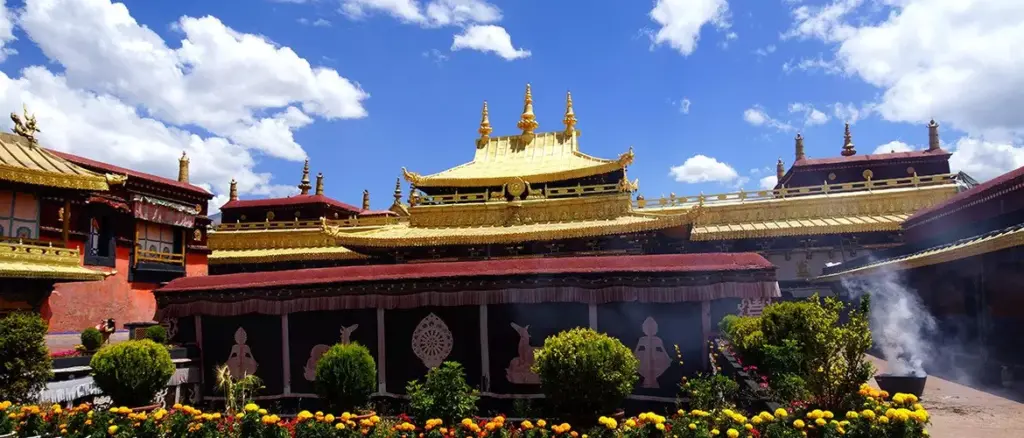
An Essential Guide to Visiting Jokhang Temple
Nestled in the heart of Lhasa, Jokhang Temple stands as a beacon of spirituality and a testament to Tibet’s rich cultural heritage. Revered as the holiest site in Tibetan Buddhism, this ancient temple draws thousands of pilgrims and visitors alike, all eager to experience its sacred atmosphere and to walk the revered kora that encircles its hallowed grounds. Built in the 7th century, Jokhang has witnessed centuries of devotion, architectural evolution, and the intertwining of various cultural influences, making it not just a place of worship but also a living museum of Tibetan history and artistry.
As you approach the temple, the air thickens with the scent of burning juniper and the sound of chanting fills your ears, immersing you in a sensory tapestry that is uniquely Tibetan. The vibrant sights of colorful prayer flags fluttering in the breeze, coupled with the sight of dedicated pilgrims performing prostrations, create an unparalleled experience that resonates deeply with the soul. Whether you are a devout Buddhist or a curious traveler seeking to understand the spiritual heart of Tibet, your visit to Jokhang Temple promises to be a transformative journey.
In this guide, we will delve into the history, significance, and practical tips for visiting this sacred site, ensuring you make the most of your time at Jokhang Temple. Prepare to uncover the legends that shaped its existence, marvel at its architectural beauty, and witness the profound devotion of those who come to pay their respects.
In This Guide
- An Essential Guide to Visiting Jokhang Temple
- The Rich History and Legends of Jokhang Temple
- Main Highlights: What You Absolutely Can’t Miss
- Planning Your Visit: A Practical Guide
- Tickets: Prices, Booking, and Tips
- How to Get There: A Complete Transportation Guide
- Local Cuisine and Accommodation Nearby
- Frequently Asked Questions
- Final Thoughts on Your Trip
The Rich History and Legends of Jokhang Temple
The Jokhang Temple, known as Tsuglhakhang in Tibetan, stands as an emblematic beacon of Lhasa, cradling the spiritual heart of Tibet within its ancient walls. Established in 652 AD by King Srongtsen Gampo, this sacred site was built to honor his union with Princess Bhrikuti of Nepal, who brought with her the revered statue of the eight-year-old Akshobhya Buddha. This statue now resides in the nearby Ramoche Temple, while the Jokhang is home to the life-sized statue of Jowo Sakyamuni, a gift from his second wife, Princess Wencheng of the Tang Dynasty.
The construction of Jokhang Temple is steeped in captivating legends. One popular tale recounts how King Srongtsen Gampo, in search of a fitting location for his temple, tossed his ring into the air. He vowed to build where it landed, which, to his surprise, fell into a lake. This act led to the miraculous emergence of a white stupa. The king then used thousands of rams to fill the lake with sand and soil, paving the way for the temple’s foundation. Alternatively, some believe that Princess Wencheng played a pivotal role in selecting the site based on geomantic principles, ensuring the temple would be built on auspicious ground to ward off misfortune.
Throughout its 1,400-year existence, the Jokhang Temple has weathered periods of both reverence and persecution. During the reign of King Tresang Detsan, from 755 to 797 AD, Buddhists faced significant oppression, and the temple itself was targeted. The anti-Buddhist campaigns in the late ninth and early tenth centuries saw Jokhang and Ramoche transformed into stables, yet they survived to become symbols of resilience.
Architecturally, Jokhang Temple is a masterpiece that showcases a blend of Tibetan, Tang Dynasty, and Nepalese designs. Its structure has undergone multiple reconstructions through the Yuan, Ming, and Qing dynasties, leading to the expansive complex that captivates visitors today. Spanning over 25,000 square meters, the temple features three floors, chapels, and an open roof, making it an essential stop for anyone exploring Lhasa.
The temple’s name holds profound significance. Originally, Lhasa was called “Rasa,” meaning the land of rams, a nod to the animals used in its construction. It was later renamed Jokhang, translating to “House of Buddha,” and the city became known as Lhasa, meaning “Land of Buddha.” This etymological evolution emphasizes the temple’s foundational role in the identity of Lhasa and its deep cultural heritage.
A remarkable incident in recent history further solidified the temple’s status as a sacred site. On February 17, 2018, a fire broke out at Jokhang Temple, but miraculously, it was contained without any loss of life or damage to invaluable cultural relics. Many Tibetans viewed this as a divine intervention, reinforcing the temple’s reputation as a spiritual stronghold.
Today, the Jokhang Temple continues to be a vibrant hub of devotion and pilgrimage. Visitors can witness daily kora (circumambulation) rituals performed by locals, offering a glimpse into the profound spiritual practices that have endured for centuries. Whether tracing the footsteps of ancient pilgrims or marveling at the intricate architecture, those who visit Jokhang Temple step into a living tapestry of Tibetan history, culture, and faith.
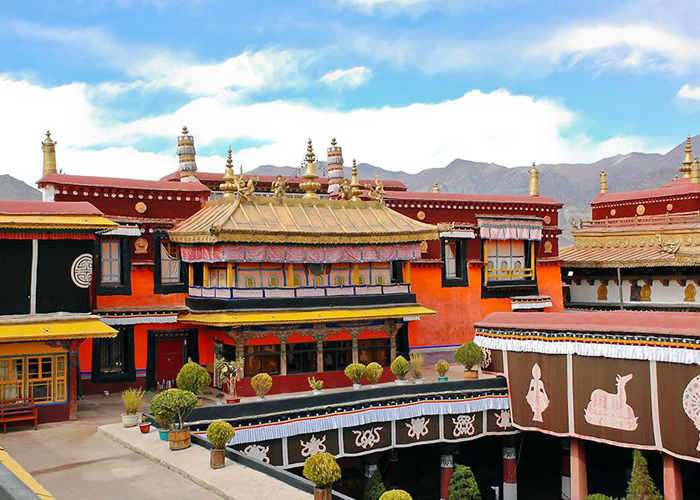
Jokhang Temple.
Main Highlights: What You Absolutely Can’t Miss
As you embark on your journey to Jokhang Temple, the spiritual heart of Tibet, prepare to be captivated by its rich history, vibrant atmosphere, and stunning architecture. Here are the essential highlights you absolutely can’t miss during your visit:
The Historical Significance
Jokhang Temple, also known as Tsuglhakhang, is more than just a religious site; it is the oldest and holiest temple in Lhasa. Built in 652 AD by King Srongtsen Gampo, the temple was constructed to honor his marriage to Princess Bhrikuti of Nepal and later Princess Wencheng of the Tang dynasty. These royal connections played a pivotal role in establishing Buddhism in Tibet, making the temple a crucial element of Tibetan culture and history.
Architectural Marvel
Marvel at the extraordinary architecture of Jokhang Temple, which seamlessly blends Tibetan, Chinese, Nepali, and Indian styles. As you explore its three floors and numerous chapels, take note of the exquisite wood carvings and intricate murals that tell the stories of Tibetan Buddhism. The temple’s golden rooftop, a symbol of its spiritual importance, offers a striking contrast against the backdrop of the Lhasa sky.
The Kora Experience
Engage with local pilgrims by participating in the Barkhor Kora, the sacred circuit that encircles the temple. This experience is particularly enchanting in the early morning when devotees spin prayer wheels, chant mantras, and perform prostrations. Walking clockwise along the Kora not only allows you to soak in the spiritual ambiance but also offers a chance to witness the deep devotion of the Tibetan people.
The Treasures Within
Step inside to discover the temple’s most revered relics, including the life-size statue of Jowo Sakyamuni, which is considered the most sacred image in Tibetan Buddhism. The interior is filled with chapels housing priceless artifacts, and the atmosphere is imbued with a sense of tranquility and reverence. Don’t forget to spend time admiring the unique Tubo-era architectural features, which encapsulate the temple’s historical significance.
Pilgrim Rituals
Take a moment to pause at the front gate, where a multitude of local pilgrims gather to perform their rituals. Witnessing their acts of devotion offers a profound insight into Tibetan spirituality. While you may be tempted to capture these moments on camera, remember to respect their privacy and refrain from intrusive photography.
Festivals and Celebrations
If your visit coincides with Tibetan festivals, you are in for a treat. The Tibetan New Year (Losar) and the Tsongkhapa Butter Lamp Festival are vibrant occasions that draw crowds in traditional attire, with monks performing colorful rituals. Being part of these celebrations offers a unique glimpse into Tibetan culture and the joyous spirit of its people.
A Personal Connection
Don’t miss the Kora on the second floor, which, although brief, is steeped in significance. This elevated circumambulation provides a quieter, more intimate atmosphere, allowing for personal reflection and connection with the spiritual essence of Jokhang Temple.
Practical Tips
Plan your visit during the morning hours, ideally arriving around 8 a.m., to fully appreciate the bustling activity of local pilgrims. The temple is open from 8:30 a.m. to 6:30 p.m., but the early hours grant an authentic experience of Tibetan worship. Remember to walk clockwise through the temple and take your time to absorb the atmosphere.
Jokhang Temple is not just a destination; it is an embodiment of Tibetan faith, culture, and history. Each corner tells a story, and each moment spent within its walls brings you closer to the heart of Tibetan spirituality.
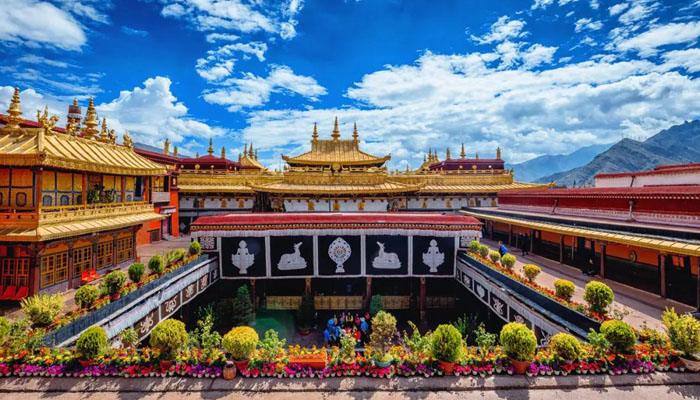
Jokhang Temple.
Planning Your Visit: A Practical Guide
Visiting Jokhang Temple offers an unparalleled glimpse into the spiritual heart of Tibet, where centuries of tradition and devotion come alive. Here’s your practical guide to making the most of your visit to this sacred site in Lhasa, ensuring a meaningful and enriching experience.
Getting There
Location: Jokhang Temple is conveniently located in the heart of Lhasa, approximately 1,000 meters east of the iconic Potala Palace.
Transportation:
– Walking: If you’re staying in central Lhasa, the temple is within walking distance from most hotels and attractions.
– Public Transport: Local buses and taxis are available, but walking is recommended to soak in the vibrant atmosphere of the Barkhor area.
Best Time to Visit
Seasons:
– Winter (November to March): This season is ideal for witnessing local Tibetan pilgrims who flock to Jokhang Temple after the harvest.
– Tibetan Festivals: If your visit coincides with Tibetan New Year or the Tsongkhapa Butter Lamp Festival, you’ll experience the temple in its most festive spirit.
Opening Hours: The temple is open daily from 8:30 a.m. to 6:30 p.m. Arrive early, around 8 a.m., to witness the morning rituals of local pilgrims.
What to Expect
Pilgrimage Experience:
– Barkhor Kora: Start your visit by walking the Barkhor Kora, a sacred circuit around the temple. The best time is between 9 and 10 a.m., when locals perform their circumambulations, spinning prayer wheels and chanting mantras.
– Front Gate Rituals: Pause at the main entrance to observe pilgrims engaging in meditation and prayers. Remember to be respectful and avoid intrusive photography.
Inside the Temple:
– Exploration: Once inside, take your time to appreciate the intricate architecture and cultural relics. Key highlights include the life-sized statue of Sakyamuni Buddha and stunning murals.
– Second Floor Kora: Don’t miss the short but significant Kora on the second floor, offering a unique opportunity for quiet reflection close to the sacred Buddha.
Tips for a Meaningful Visit
- Respect Local Customs: Dress modestly and maintain a respectful demeanor. Remember that this is a place of worship.
- Join in the Rituals: If you feel comfortable, participate in the rituals, such as spinning prayer wheels or quietly observing the ceremonies.
- Photography: While photography is allowed, be mindful of the sacred space and avoid taking close-up shots of individuals engaged in prayer.
Cultural Insights
Historical Significance: Jokhang Temple, built in the 7th century, is not just a temple but the heart of Tibetan Buddhism. Understanding its history will deepen your appreciation of the site.
Local Connections: Engage with locals, many of whom come to the temple as part of their spiritual practice. Their stories can offer profound insights into Tibetan beliefs and traditions.
Nearby Attractions
After visiting Jokhang Temple, consider exploring these nearby sites:
– Barkhor Street: A bustling marketplace filled with local handicrafts, shops, and eateries.
– Potala Palace: Just a short walk away, this iconic structure is a must-see for its grandeur and historical significance.
Final Thoughts
A visit to Jokhang Temple is an opportunity to connect with the spiritual essence of Tibet. By planning your visit thoughtfully, respecting local customs, and immersing yourself in the experience, you will gain a deeper understanding of this sacred site and its profound impact on Tibetan culture. Embrace the serenity, and allow the temple’s rich history to resonate within you as you walk its hallowed halls.
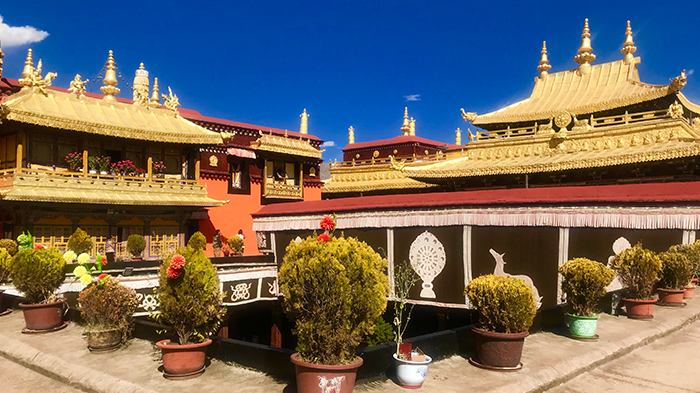
Jokhang Temple.
Tickets: Prices, Booking, and Tips
Visiting the Jokhang Temple is a profound experience, offering a unique glimpse into Tibetan spirituality and culture. Here’s everything you need to know about tickets, prices, and helpful tips for booking your visit.
Ticket Information
Access to the Jokhang Temple is incredibly affordable, allowing everyone to partake in this sacred site. As of 2023, the entrance fee is approximately ¥85 (about $12) per person. This nominal fee contributes to the preservation of the temple and ensures that it remains an accessible place for both pilgrims and tourists.
Booking Your Ticket
Tickets can be purchased directly at the temple entrance, making it straightforward for travelers. However, during peak seasons, particularly around Tibetan festivals or public holidays, you may encounter longer lines. To avoid the rush, it’s advisable to arrive early in the morning when the temple opens at 8:30 a.m. This timing allows you to experience the spiritual atmosphere as local pilgrims perform their rituals.
If you’re part of a guided tour or a travel agency, your entrance fee may already be included in your package. Be sure to check with your tour operator for specifics regarding your itinerary.
Tips for a Smooth Visit
-
Timing is Everything: To witness the most vibrant displays of devotion, plan your visit during the morning hours. Arriving around 8 a.m. will give you the chance to see local worshippers engage in their kora and other rituals.
-
Dress Respectfully: Jokhang Temple is a sacred site, so it’s important to dress modestly. Ensure that your shoulders and knees are covered out of respect for the local customs.
-
Respect Local Customs: When inside the temple, it’s crucial to walk clockwise around the sacred sites and refrain from taking photographs in restricted areas. Always be mindful of those engaged in prayer and meditation.
-
Join the Kora: The Barkhor Kora, a circular route around the temple, is a wonderful way to engage with local pilgrims. Participating in this practice offers insight into Tibetan spirituality and allows for a unique personal experience.
-
Explore Beyond the Temple: After your visit, take time to explore the surrounding Barkhor Street, where you can find local shops, vibrant markets, and traditional Tibetan crafts. This area is perfect for picking up souvenirs or enjoying local cuisine.
By planning ahead and embracing the spiritual ambiance of Jokhang Temple, you can ensure a memorable and enriching experience during your visit to this iconic treasure of Lhasa.
How to Get There: A Complete Transportation Guide
Reaching Jokhang Temple, the spiritual heart of Tibet, is an adventure that brings you closer to the rich culture and profound spirituality of Lhasa. Here’s a comprehensive guide on how to navigate your way to this iconic destination.
Arriving in Lhasa
By Air
The quickest way to reach Lhasa is by flying into Lhasa Gonggar Airport (LXA), located about 60 kilometers from the city center. The airport has connections from major Chinese cities such as Beijing, Chengdu, and Xi’an. Flights often provide breathtaking views of the Himalayas, making your journey memorable from the start.
Transportation from the Airport:
- Airport Shuttle: A convenient airport shuttle service operates regularly, taking you directly to Lhasa. The journey takes approximately 1.5 hours and offers a cost-effective option.
- Taxi: Taxis are available outside the terminal, and the ride to central Lhasa costs around 200-300 CNY. Ensure you agree on the fare before starting your journey.
By Train
Traveling to Lhasa by train is a unique experience, often regarded as one of the most scenic railway journeys in the world. The train station in Lhasa (Lhasa Railway Station) is well connected to cities like Chengdu, Xining, and Beijing, with the Qinghai-Tibet Railway providing breathtaking views of the Tibetan Plateau.
- Travel Time: The journey from Xining to Lhasa takes about 24 hours, while the Chengdu to Lhasa route takes approximately 36 hours.
- Tickets: Book your tickets in advance, especially during peak travel seasons, as they can sell out quickly.
Getting to Jokhang Temple
Once you arrive in Lhasa, getting to Jokhang Temple is straightforward, given its central location.
Walking:
- From the City Center: Jokhang Temple is located in the heart of Lhasa, roughly 1,000 meters east of the Potala Palace. It’s a pleasant walk through the bustling streets of Lhasa, which allows you to soak in the local atmosphere. The walk should take about 15-20 minutes from the Potala Palace.
- Barkhor Street: As you approach the temple, you will likely enter Barkhor Street, a vibrant area filled with shops, street food, and local vendors. This street is a popular spot for pilgrims who perform the kora (circumambulation) around the temple.
Public Transport:
- Buses: Several local buses connect various parts of Lhasa to Jokhang Temple. Routes 1, 3, and 5 are commonly used by locals. Ensure you check the latest schedules, as they may vary.
- Taxis: Taxis are readily available in Lhasa and can be a convenient option, especially if you are short on time. A taxi ride from most parts of the city to Jokhang Temple should cost between 10-30 CNY.
Tips for Your Journey
- Altitude Considerations: Lhasa is located at an altitude of 3,650 meters (12,000 feet). It is advisable to take it easy upon arrival to acclimatize. Stay hydrated, avoid strenuous activities, and consider spending your first day exploring at a leisurely pace.
- Travel Permits: International travelers require a Tibet Travel Permit to enter Tibet. Make sure to arrange this in advance through a licensed travel agency.
- Best Times to Visit: Morning visits are highly recommended to witness local pilgrims performing their rituals. The temple opens at 8:30 a.m., and arriving early allows you to soak in the spiritual atmosphere before it gets crowded.
With this transportation guide, you are well-prepared to embark on your journey to Jokhang Temple. Whether you choose to fly, take the train, or explore the streets of Lhasa on foot, each step brings you closer to one of the most revered sites in Tibetan culture.

Jokhang Temple.
Local Cuisine and Accommodation Nearby
Nestled in the heart of Lhasa, near the iconic Jokhang Temple, you’ll find a delightful array of local cuisine and accommodations that reflect the rich cultural tapestry of Tibet. Whether you’re seeking a cozy restaurant to savor traditional dishes or a comfortable place to rest after a day of exploration, the area has plenty to offer.
Local Cuisine
1. The Tibet Kitchen
For a truly authentic Tibetan dining experience, The Tibet Kitchen is a must-visit. This popular eatery is known for its traditional dishes, including momos (steamed dumplings) and thukpa (noodle soup), which are both hearty and flavorful. The warm ambiance and friendly staff create an inviting atmosphere, perfect for unwinding after a day of sightseeing.
2. Lhasa Kitchen
Just a short walk from the temple, Lhasa Kitchen offers a diverse menu that highlights Tibetan, Nepali, and Indian influences. The yak meat dishes are particularly recommended, along with the butter tea—a local favorite that is both nourishing and energizing. The restaurant’s vibrant decor adds to the overall dining experience.
3. Gangjong Kitchen
If you’re in the mood for a fusion twist on Tibetan cuisine, head to Gangjong Kitchen. Here, you can enjoy dishes like Tibetan-style fried rice and spicy yak curry, often accompanied by spectacular views of the temple. The café is especially known for its selection of teas, making it a great spot to relax and take in the local atmosphere.
Accommodation Nearby
1. Joco Castle
For those seeking a unique lodging experience, Joco Castle is a standout choice. This boutique hotel, located just a stone’s throw from Jokhang Temple, features rooms adorned with traditional Tibetan decor and modern amenities. The rooftop terrace provides stunning views of Lhasa, making it an ideal spot for sunrise or sunset photographs.
2. Khangsar Hotel
Offering comfort and convenience, Khangsar Hotel is situated within walking distance of the temple. The hotel’s restaurant serves a variety of Tibetan and Chinese dishes, and guests can enjoy a cozy lounge area. The staff is known for their warm hospitality, ensuring a pleasant stay.
3. House of Shambhala
If you’re looking for a more upscale option, the House of Shambhala is perfect. This elegant hotel combines traditional Tibetan architecture with luxurious touches. Guests can enjoy spacious rooms, exquisite dining options, and a peaceful garden area. Its prime location means you can easily explore Jokhang Temple and the surrounding streets.
Conclusion
Whether you’re indulging in local flavors or resting your head in one of the charming accommodations, the area surrounding Jokhang Temple promises a rich and immersive experience. Embrace the culinary delights and welcoming lodgings as you explore the spiritual heart of Tibet.
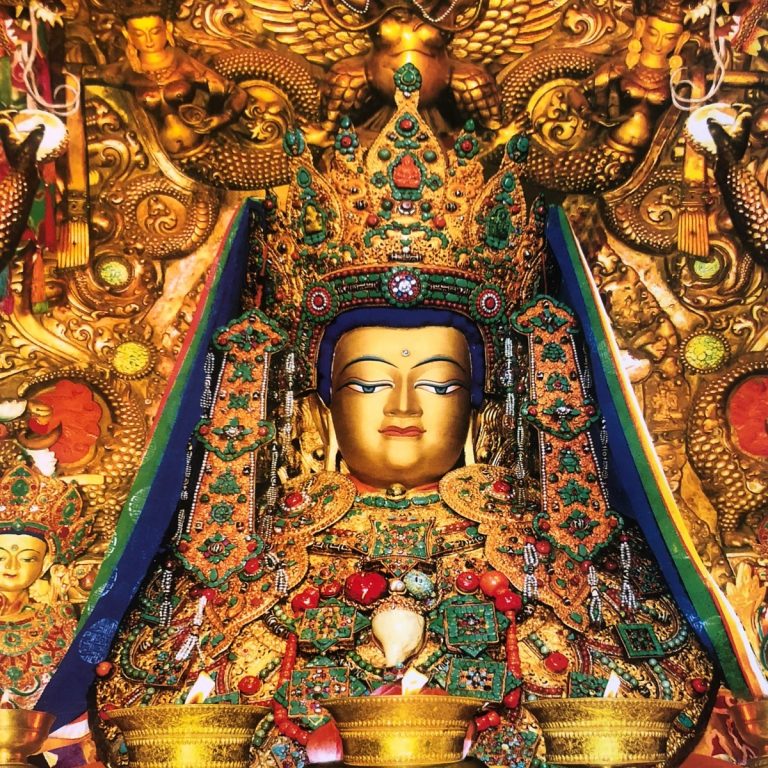
Jokhang Temple.
Frequently Asked Questions
-
What is the best time to visit Jokhang Temple?
The best time to visit Jokhang Temple is in the morning, ideally between 8:00 a.m. and 10:00 a.m. This is when you can experience the vibrant atmosphere filled with local pilgrims performing their daily kora (circumambulation) around the temple, offering a truly spiritual experience. -
How do I get to Jokhang Temple?
Jokhang Temple is located in the heart of Lhasa, approximately 1,000 meters east of the Potala Palace. You can easily reach it on foot if you’re staying in central Lhasa, or by taking a local taxi or rickshaw for convenience. -
Are there any entrance fees to visit Jokhang Temple?
Yes, there is a small entrance fee to visit the temple, which helps with its maintenance and preservation. It’s best to carry some cash, as card payments may not be accepted. -
What should I wear when visiting Jokhang Temple?
Visitors are encouraged to dress modestly and respectfully. It is advisable to wear long pants and sleeves, and to avoid revealing outfits as a sign of respect for the sacredness of the site. Comfortable shoes are also recommended for walking around. -
Can I take photographs inside Jokhang Temple?
Photography is allowed in certain areas of the temple, but it is important to be respectful of the local customs and the devotions of the pilgrims. Avoid using flash and refrain from taking close-up shots of worshippers during their rituals. -
What are the main highlights to see inside Jokhang Temple?
Inside Jokhang Temple, you can admire the life-sized statue of Sakyamuni Buddha, exquisite wood carvings, colorful murals, and numerous precious relics. Be sure to also explore the unique Tubo-era architecture that showcases a blend of Tibetan, Chinese, and Nepali styles. -
Are there any festivals or events I should plan my visit around?
Yes! If you’re visiting during the Tibetan New Year (February 18, 2026) or the Tsongkhapa Butter Lamp Festival (December 14, 2025), you’ll experience vibrant celebrations with traditional costumes, colorful rituals, and an electrifying atmosphere filled with devotion. -
What is the Kora, and why is it significant?
The Kora is a sacred circumambulation performed by pilgrims around the temple. It allows visitors to engage in spiritual practice while honoring the temple’s significance. The Barkhor Kora surrounding Jokhang Temple is particularly popular and provides an immersive experience into Tibetan culture and devotion.
Final Thoughts on Your Trip
As you prepare to conclude your journey to Jokhang Temple, take a moment to reflect on the profound spiritual and cultural tapestry that awaits you within its sacred walls. This temple is more than just a historical monument; it is the heartbeat of Tibetan Buddhism, a living testament to centuries of devotion and faith. The sights, sounds, and rituals you experience here will forever linger in your memory, painting a vivid picture of the resilience and spirituality of the Tibetan people.
Whether you walked the bustling Barkhor Kora, marveled at exquisite murals, or joined in the reverent atmosphere during a Tibetan festival, each moment spent at Jokhang Temple deepens your understanding of what it means to be part of a rich and vibrant culture.
Embrace the tranquility and the energy of this remarkable site as you leave, knowing that you have touched a piece of Tibetan history and spirituality. Carry these experiences with you, and let them inspire your future adventures. Remember, every journey begins with a single step, and you have just taken one of the most significant steps in exploring the soul of Tibet. Safe travels, and may your heart remain open to the wonders that lie ahead!